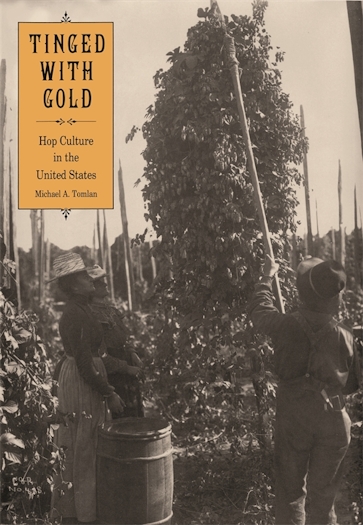Tinged with Gold
Hop Culture in the United States
Title Details
Pages: 288
Illustrations: 110 illus.
Trim size: 7.000in x 10.000in
Formats
Paperback
Pub Date: 11/15/2013
ISBN: 9-780-8203-4674-8
List Price: $29.95
eBook
Pub Date: 11/15/2013
ISBN: 9-780-8203-4708-0
List Price: $29.95
Related Subjects
Tinged with Gold
Hop Culture in the United States
Skip to
- Description
- Reviews
Today hop growing remains a viable commercial enterprise only in parts of the far western United States—notably in Washington. But, as James Fenimore Cooper remembered, the mid-nineteenth century in Cooperstown, New York, was a time when "the 'hop was king,' and the whole countryside was one great hop yard, and beautiful".
In Tinged with Gold, Michael A. TomIan explores all aspects of hop culture in the United States and provides a background for understanding the buildings devoted to drying, baling, and storing hops. The work considers the history of these structures as it illustrates their development over almost two centuries, the result of agrarian commercialism and nearly continuous technological improvement. In examining the context in which the buildings were constructed, Tomlan considers the growth, cultivation, and harvesting of the plant; the economic, social, and recreational activities of the people involved in hop culture; and the record of mechanical inventions and technical developments that shaped hop kilns, hop houses, and hop driers and coolers in the various areas where the crop flourished. The work challenges assumptions about the noncommercial nature of American agriculture in the eighteenth and early nineteenth centuries and raises important questions about the "folk" tradition of hop houses, arguing that the designs of these buildings were rational responses to commercial imperatives rather than the continuance of arcane English or European customs.
Tinged with Gold brings hop culture to life as it explores the history of this neglected aspect of rural agriculture. Because the work demonstrates that the significance of a relatively obscure building type can be fully appreciated if placed in its historical context, it provides a model for studying other rural structures. Drawing upon an impressive array of primary and secondary sources, this work is a definitive history of hop culture in the United States.
Original maps, historic and recent photographs, a marvelous bird's-eye view, and penetrating character studies of hop pickers contribute magnificently to this volume . . . Gratitude is due to Tomlan for his interdisciplinary study, drawn from extensive and detailed field observations and library work from New England to the Pacific; for the impressive and useful array of notes and sources; and for providing a model study that should inspire further inquiry into these 'buildings behind the farmhouse.'
—Journal of American History
A solid, interesting and entertaining basis for the understanding of hop production in the United States. . . . This book synthesizes a diverse and often obscure literature of one of the more important specialty crops of the United States. Drawing from agronomists, geographers, historians, economists, and others, Tomlan has created an interdisciplinary history of hop culture in the United States up to approximately the Second World War. The volume is thorough, well endowed with maps, graphs, photographs, and diagrams
—Agricultural History
A first-rate work of scholarship. The author writes well, uses the latest methodological research techniques, and fllls a major void in our understanding of an important, but nearly forgotten, chapter in United States agricultural history.
—Journal of the West
A lucidly written, creditable piece of scholarship, Tinged With Gold is complemented by photographs, superb architectural designs, maps, and other illustrations, along with what appears to be for so obscure a subject a comprehensive bibliography. Obviously a labor of love representing years of painstaking research, the book, according to the publisher, stands as the definitive account of the subject. It would indeed be hard to dispute that claim.
—New York History
Hops may be a minor crop used to make beer, but as Tomlan demonstrates, they can provide a major window into the hsitory of American farming. . . . Tomlan's wonderfully illustrated, well-researched monograph provides a comprehensive overview of three centuries of agricultural change.
—Choice



